Tactical Asset Allocation - April 2025

Synopsis
Our framework remains in a contraction regime for the 10th consecutive month. US tariffs likely to fuel further downgrades in growth expectations and global risk appetite. We maintain a cautious asset allocation versus benchmark, overweighting fixed income relative to equities. We remain neutral developed ex-US equities vs. US equities and underweight in emerging markets. In fixed income, overweight duration via inflation-linked bonds, and underweight credit risk.
The rotation into non-US equities continues. While earnings momentum provides a fundamental backdrop for this rotation, our process leads us to wait for a rebound in global risk appetite and a depreciating dollar to move more decisively into developed ex-US equities. We remain neutral.
Maintaining defensive portfolio positioning, favoring fixed income over equities, and underweighting credit risk. Overweight low volatility and quality stocks and staying neutral developed ex-US equities relative to US equities.
Our macro process drives tactical asset allocation decisions over a time horizon between six months and three years, on average, seeking to harvest relative value and return opportunities between asset classes (e.g., equity, credit, government bonds, and alternatives), regions, factors, and risk premia.
Macro update
Market sentiment and growth expectations are weakening. This is somewhat in contrast with hard economic data showing that global growth has improved over the past few months, especially in Europe, where leading economic indicators are rebounding from cycle lows (Figures 1 and 2). However, at this stage, hard economic statistics are likely telling something about the past rather than the future. Following the substantial outperformance in 2024, US leading indicators are softening, led by weakness in business and consumer sentiment surveys negatively impacted by global tariffs and policy uncertainty. As of March 31, global risk appetite continues to weaken at a moderate pace, as global equities underperform fixed income year-to-date and credit spreads widened across all fixed income sectors over the past month, led by US HY spreads wider by more than 60 basis points (bps), bank loans by more than 30bps, followed by IG and EM hard currency debt. At the time of this writing, these magnitudes are yet to incorporate market dynamics following US tariffs announced on April 2. Our framework remains in a contraction regime for the global economy and its major regions for the 10th consecutive month.
The positioning unwind in US momentum and growth stocks continues, benefiting a rotation into value and low volatility stocks, factors shunned by the market for years. Alongside this rotation, the underperformance of US equities versus global developed and emerging markets persisted in March, fueling the trend since the start of the year and characterizing the first quarter of 2025 with a sizeable outperformance of 15% for international developed markets relative to the S&P 500, the largest since Q4 2022. The outperformance was consistent and widespread across the Eurozone, UK and Japan. As detailed over the past two months, we believe this rotation is not simply driven by short-term technical positioning but finds fundamental support in the cyclical divergence of upward earnings revisions in Europe vs. downward earnings revisions in the United States. After entering the year with maximum underweight exposure to developed ex-US equities, today, we remain neutral and wait for additional catalysts to confirm or deny the strength and durability of this rotation.

Sources: Bloomberg L.P., Macrobond. Invesco Solutions research and calculations. Proprietary leading economic indicators of Invesco Solutions. Macro regime data as of Mar. 31, 2025. The Leading Economic Indicators (LEIs) are proprietary, forward-looking measures of the level of economic growth. The Global Risk Appetite Cycle Indicator (GRACI) is a proprietary measure of the markets’ risk sentiment. Developed markets ex-USA include the eurozone, UK, Japan, Switzerland, Canada, Sweden, Australia. Emerging markets include Brazil, Mexico, Russia, South Africa, Taiwan, China, South Korea, India.

Source: Invesco Solutions, as of Mar. 31, 2025.

Sources: Bloomberg L.P., Macrobond. Invesco Solutions research and calculations. Proprietary leading economic indicators of Invesco Solutions. Macro regime data as of Mar. 31, 2025. The Leading Economic Indicators (LEIs) are proprietary, forward-looking measures of the level of economic growth. The Global Risk Appetite Cycle Indicator (GRACI) is a proprietary measure of the markets’ risk sentiment.

Sources: Bloomberg L.P., MSCI, FTSE, Barclays, JPMorgan, Invesco Solutions research and calculations, from Jan. 1, 1992 to Mar. 31, 2025. The Global Leading Economic Indicator (LEI) is a proprietary, forward-looking measure of the growth level in the economy. A reading above (below) 100 on the Global LEI signals growth above (below) a long-term average. The Global Risk Appetite Cycle Indicator (GRACI) is a proprietary measure of the markets’ risk sentiment. A reading above (below) zero signals a positive (negative) compensation for risk-taking in global capital markets in the recent past. Past performance does not guarantee future results.
As previously illustrated, our systematic approach to regional equity allocations is driven by three fundamental market drivers:
- Global growth expectations inform the overall macro backdrop. Regions/countries with more cyclical exposure and operating leverage to the global cycle tend to outperform (underperform) when growth expectations are rising (falling). Today, international developed markets exhibit more cyclical properties relative to the US. Our global risk appetite indicator (GRACI), a real-time proxy of market-implied global growth expectations, points to decelerating growth expectations, hence still favoring US equities. Critically, the global impact of US tariffs will likely be the primary driver of risk sentiment over the next few weeks.
- Relative earnings revisions provide an indication of the relative momentum in analyst forecasts and the expected fundamental strength between the two markets. Today, cyclical divergence with upward revisions in developed ex-US equities versus downward revisions in the United States favors international developed markets.
- US dollar cycles play a significant role in terms of performance contribution within unhedged equity markets, as well as driving the global liquidity cycle. Periods of US dollar outperformance (underperformance) tend to coincide with periods of US equities outperformance (underperformance) versus other equity markets. Today, our US dollar framework provides a neutral view on the greenback. Dollar strength originating from tighter monetary policy and higher yields is offset by headwinds from positive growth surprises in the rest of the world, favoring other currencies such as the euro, the British pound, etc. Overall, our US dollar framework offers no signal in favor of either US or other developed market equities at this stage. US trade policy is causing substantial volatility in currency markets and is likely to shift our models towards a bearish US dollar view in the near term. In this regard, long-term currency valuations suggest the potential for a meaningful and long-lasting US dollar depreciation cycle. Broad-based US tariffs may provide the catalyst for this rotation (Figure 3).
As illustrated in Figure 4, historically, when all three drivers align with a consistent signal in favor of one region, the relative performance between the two markets tends to align with these fundamentals. Today, the fundamental picture remains mixed as we wait for rising global risk appetite and a weakening US dollar to confirm the recent shift in earnings momentum towards non-US markets.
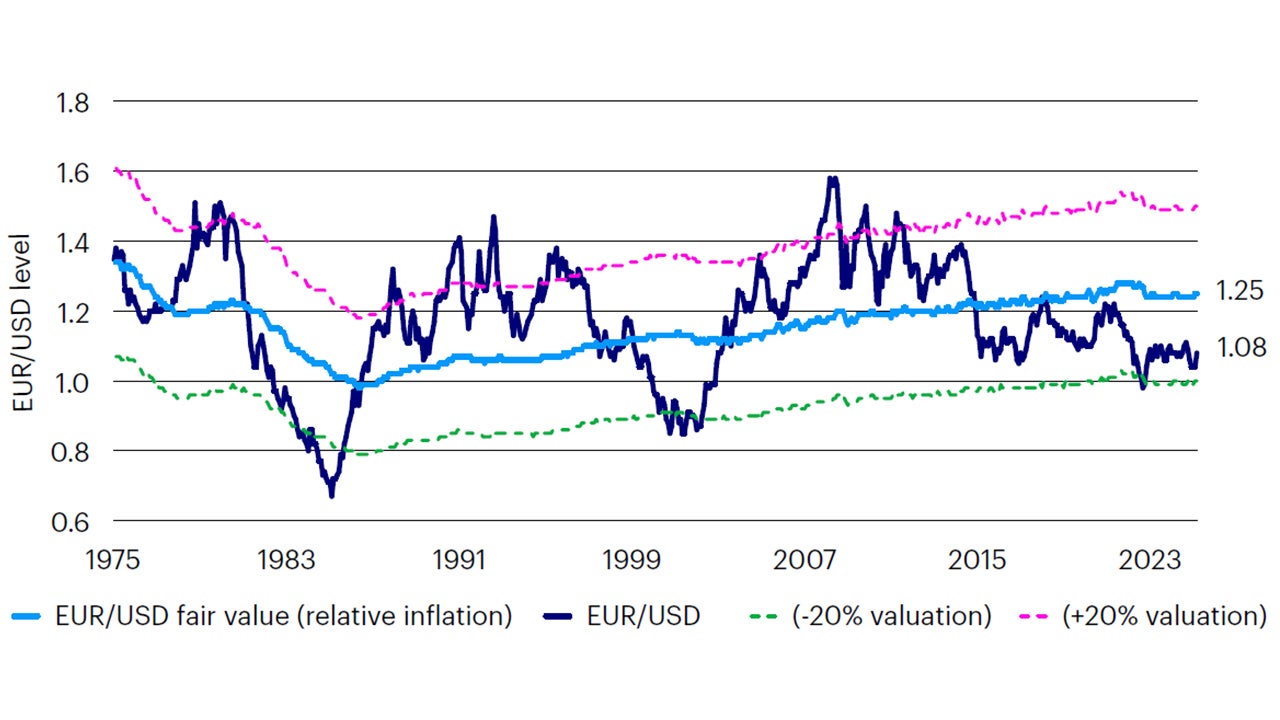
Sources: Bloomberg L.P., Invesco Solutions calculations. Pre-1999 EUR/USD exchange rate computed by Bloomberg as weighted average of legacy European currencies. Fair value represented by relative purchasing power parity, i.e., relative inflation differentials using headline CPI. January 1975 – March 2025.
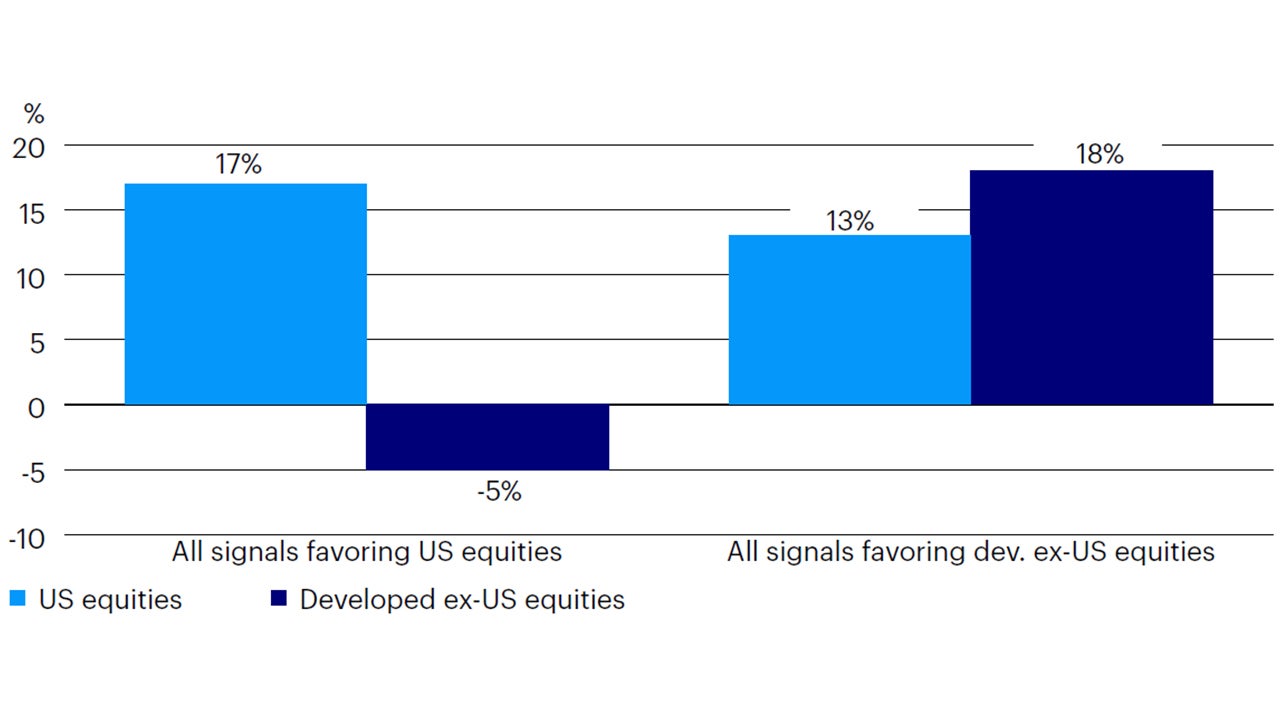
Sources: Invesco Solutions. Global growth expectations represented by Global Risk Appetite Indicator (GRACI). Earnings revisions measured as the spread between 12-month forward earnings between regions. US dollar signal based on relative monetary policy stance and growth performance relative to consensus. US equities = MSCI USA total return index, developed ex-US equities = MSCI World ex-USA total return index. January 1994 – March 2025.
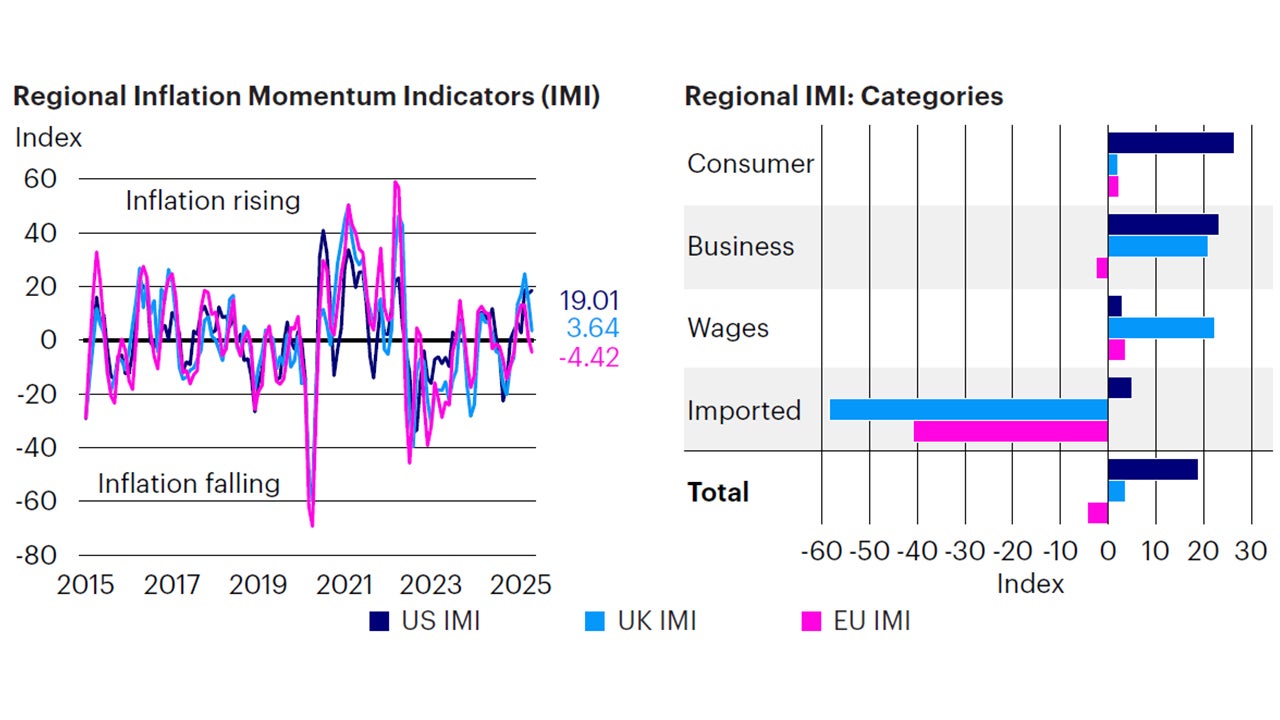
Sources: Bloomberg L.P., data as of Mar. 31, 2025, Invesco Solutions calculations. The US Inflation Momentum Indicator (IMI) measures the change in inflation statistics on a trailing three-month basis, covering indicators across consumer and producer prices, inflation expectation surveys, import prices, wages, and energy prices. A positive (negative) reading indicates inflation has been rising (falling) on average over the past three months.
Investment positioning
We implemented no changes to our asset allocation this month in the Global Tactical Allocation Model.1 We remain underweight risk relative to benchmark, underweighting equities relative fixed income, primarily via an underweight to emerging markets versus developed markets. We maintain a neutral stance between US and international developed market equities, and overweight to defensive sectors with quality and low volatility characteristics. In fixed income, we underweight credit risk2 relative to benchmark and overweight duration via inflation-linked bonds at the expense of nominal Treasuries (Figures 6 to 9). In particular:
- In equities, we remain neutral between US and developed ex-US equities. Going forward, a bearish outlook for the US dollar or a rebound in global risk appetite would be necessary for our framework to trigger an overweight to developed markets outside the US, assuming recent momentum in earnings remains in place. We maintain a moderate underweight in emerging market equities relative to developed markets and still favor defensive sectors with quality and low volatility characteristics, tilting towards larger capitalizations at the expense of value, mid, and small caps. Low volatility equities continued to deliver downside protection in the recent round of equity volatility. We maintain exposures to defensive sectors such as health care, staples, utilities, and technology at the expense of cyclical sectors such as financials, industrials, materials, and energy.
- In fixed income, we continue to underweight credit risk and overweight duration, favoring investment grade and sovereign fixed income relative to high yield. Given the decelerating growth environment and credit spreads at cycle lows, we believe the risk-reward in this position is attractive. Recent spread widening across credit sectors has supported this position. In sovereigns, we maintain a maximum overweight exposure to US TIPS relative to nominal Treasuries, given rising inflation momentum in the US (Figure 5).
- In currency markets, we maintain a neutral stance on the US dollar. While economic data outside the US are still surprising to the upside, wider yield differentials towards the greenback lead our models to a neutral position in aggregate. Within developed markets, we favor the euro, British pound, Norwegian kroner, Swedish krona, and Singapore dollar relative to the Swiss Franc, Japanese yen, and Australian and Canadian dollars. In EM, we favor high yielders with attractive valuations, such as the Colombian peso, Brazilian real, Indian rupee, Indonesian rupiah, and Mexican peso relative to low yielding and more expensive currencies, such as the Korean won, Taiwan dollar, Philippines peso, and Chinese renminbi.
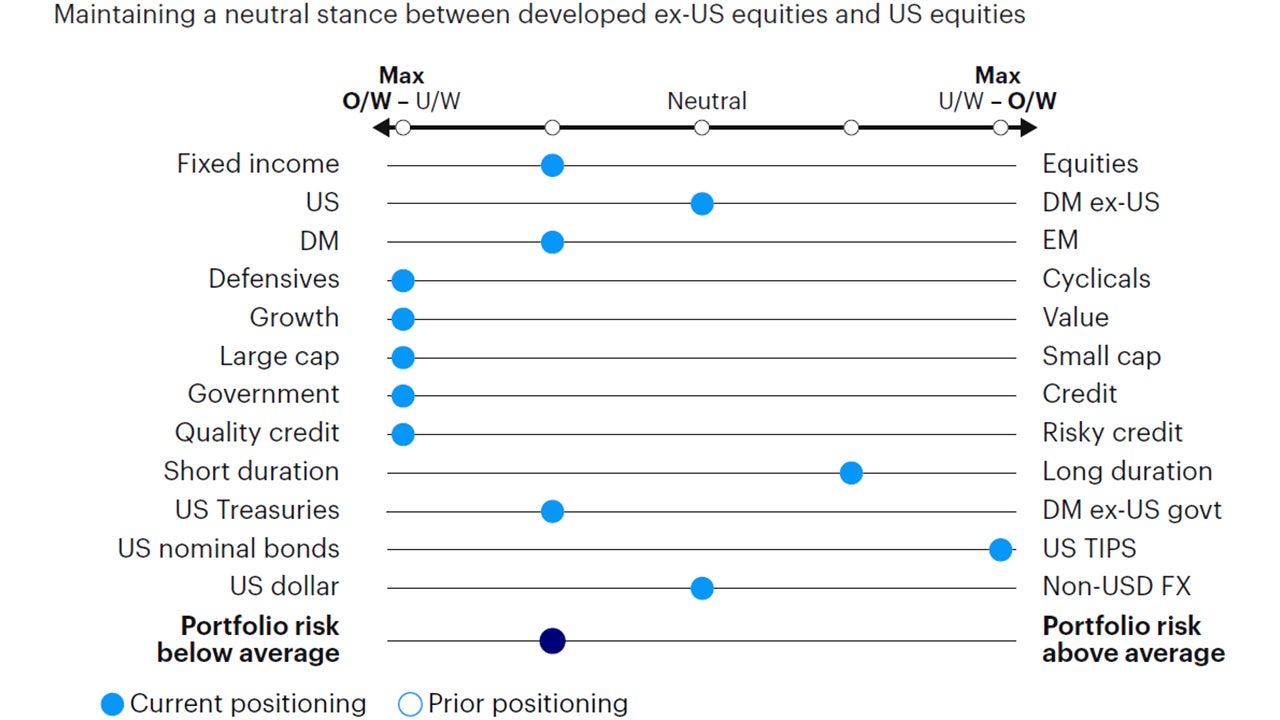
Source: Invesco Solutions, Apr. 1, 2025. DM = developed markets. EM = emerging markets. Non-USD FX refers to foreign exchange exposure as represented by the currency composition of the MSCI ACWI Index. For illustrative purposes only.

Source: Invesco Solutions, Apr. 1, 2025. For illustrative purposes only. Neutral refers to an equally weighted factor portfolio.
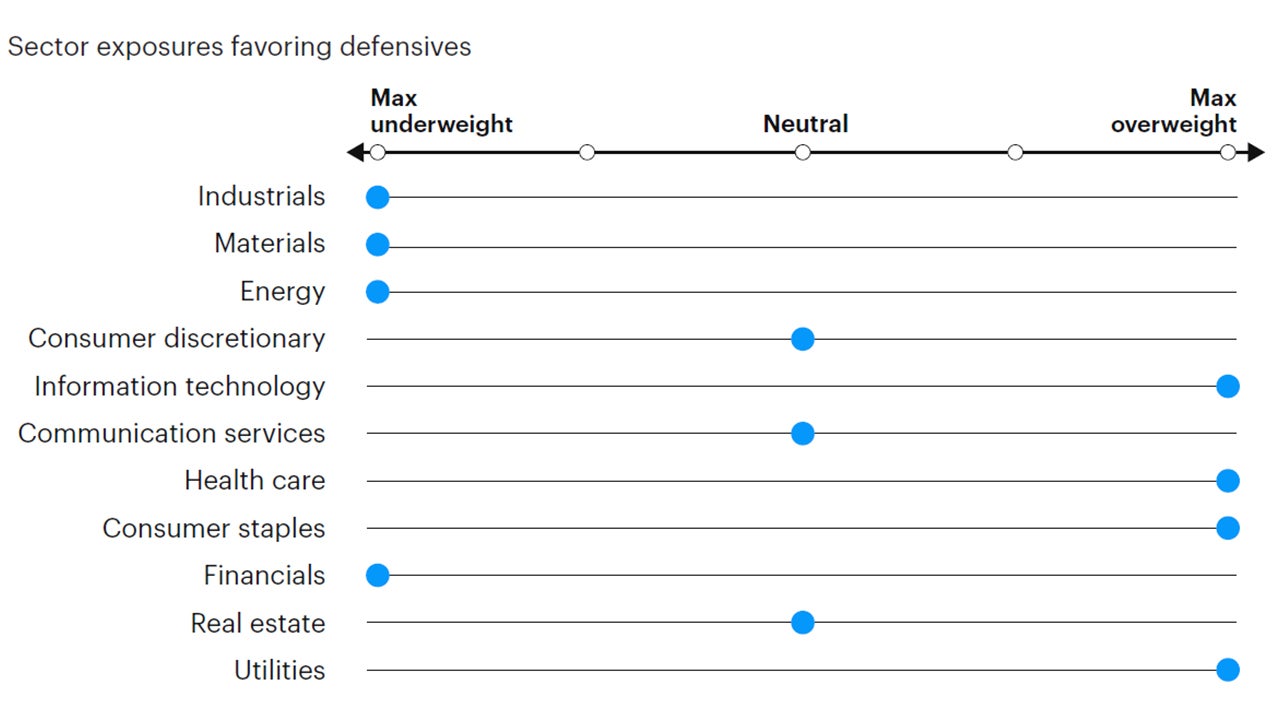
Source: Invesco Solutions, Apr. 1, 2025. For illustrative purposes only. Sector allocations derived from factor and style allocations based on proprietary sector classification methodology. As of December 2023, Cyclicals: energy, financials, industrials, materials; Defensives: consumer staples, health care, information technology, real estate, utilities; Neutral: consumer discretionary and communication services.

Source: Invesco Solutions, Apr. 1, 2025. For illustrative purposes only. Currency allocation process considers four drivers of foreign exchange markets: 1) US monetary policy relative to the rest of the world, 2) global growth relative to consensus expectations, 3) currency yields (i.e., carry), 4) currency long-term valuations.
Investment risks
The value of investments and any income will fluctuate (this may partly be the result of exchange rate fluctuations), and investors may not get back the full amount invested.
Footnotes
-
1
Reference benchmark 60% MSCI ACWI, 40% Bloomberg Global Aggregate Hedged Index.
-
2
Credit risk defined as duration times spread (DTS).




